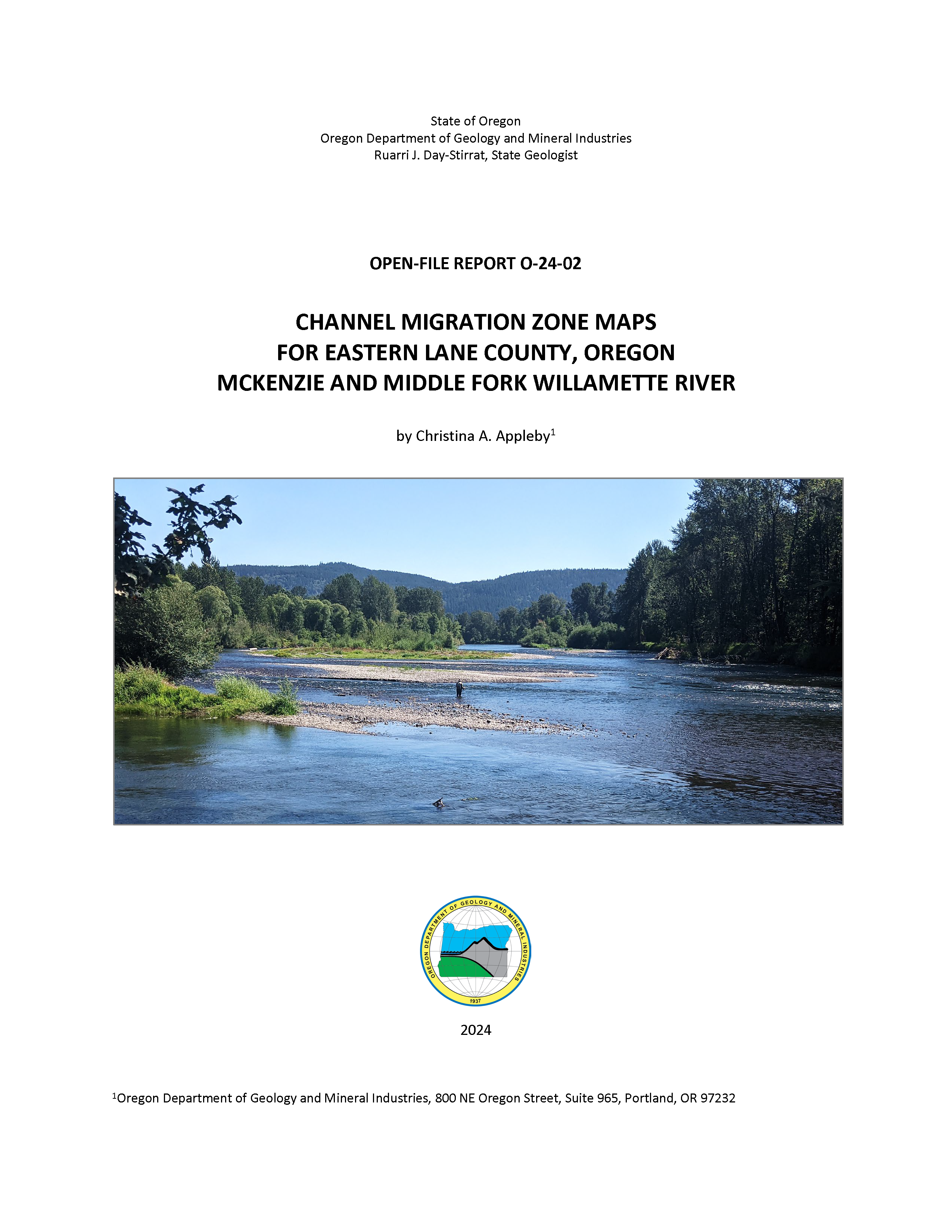DOGAMI OPEN-FILE REPORT SERIES
Publication Preview

Open-File Report O-24-02, Channel Migration Zone Maps for Eastern Lane County, Oregon, McKenzie and Middle Fork Willamette River, by Christina A. Appleby; 64 p. report, one Esri® geodatabase with internal metadata, external metadata in .xml format.
WHAT’S IN THIS REPORT?
This report describes the methods and results of channel migration zone mapping for eastern Lane County, Oregon. This information can help communities plan and prepare for natural disasters.
PUBLICATION DOWNLOADS
EXECUTIVE SUMMARY
This study provides Oregon communities with new information about the natural hazards from channel migration. During 2022 and 2023, the Oregon Department of Geology and Mineral Industries (DOGAMI) produced channel migration zone (CMZ) maps for the McKenzie and Middle Fork Willamette Rivers in eastern Lane County. These maps are the first of their kind published for these rivers.
CMZ maps define the area in which a given stream is likely to move laterally and change its channel course within the next 30 and 100 years. In this study, CMZs were mapped along 67 miles (108 kilometers) of the McKenzie River and 18 mi (29 km) of the lower Middle Fork Willamette River. The components that comprise these CMZ maps are the active channel; historical migration area; 30-year high, 30-year medium, and 100-year low erosion hazard areas; avulsion hazard area; and flagged stream banks. The method used was primarily based on the interpretation of historical aerial photographs, high-resolution lidar topography, geologic maps, and flood inundation maps.
The CMZ maps produced for this study of the McKenzie and Middle Fork Willamette Rivers show that, despite the anthropogenic controlling factors of dams, levees, bridges, revetments, and other infrastructure, a little more than half of the river segments in the McKenzie River and all of the Middle Fork Willamette River segments experienced some degree of lateral migration during the last 50-60 years. Many previous studies have shown that both rivers have become more geomorphically stable since river flow, sediment supply, and lateral movements have been regulated or limited by dams and other infrastructure. While this is true, this study shows that, between the late 1960s and 2022, both rivers have continued to migrate despite these constraints. If this trend continues, they may put people and infrastructure at risk.
CMZ maps are designed to aid in community planning, raise awareness of riverine flood and erosional hazards, and to inform decisions about environmental and emergency management and land use. The maps may be used to identify which buildings, critical facilities, transportation infrastructure, and utility lines are potentially at risk from channel migration and to prioritize areas for pre-disaster risk reduction. The maps in this study do not replace a site-specific analysis by a land surveyor, geologist, engineer, or some combination thereof. These hazard maps will provide a timely and valuable resource for the county and community planning efforts including during the development of emergency plans and natural hazard mitigation plan updates.
GEOGRAPHIC INFORMATION SYSTEM (GIS) DATA
Geodatabase is ESRI® version 10.7 format. Metadata are embedded in the geodatabase and are also provided as separate .xml format files.
Each dataset listed below has an associated, standalone .xml file containing metadata in the Federal Geographic Data Committee Content Standard for Digital Geospatial Metadata format.
|
Dataset Type | Description |
Channel Migration Zone (CMZ)
| This polygon represents the area within which a channel is likely to move laterally during the following 100-years.
|
Active Channel (AC)
|
This polygon represents the area within the floodplain that regularly conveys water including the exposed, unvegetated sediment deposits both within and adjacent to the river.
|
Historical Migration Area (HMA)
| This polygon represents the channel has occupied in the historical photographic record, including the active channel.
|
High Erosion Hazard Area (EHA)
| This polygon represents the areas with high potential to be impacted by lateral migration and channel widening during the following 30-years based on median historical erosion rates.
|
Medium Erosion Hazard Area (EHA)
| This polygon represents the areas with medium potential to be impacted by lateral migration and channel widening during the following 30-years based on maximum historical erosion rates.
|
Low Erosion Hazard Area (EHA)
| This polygon represents the areas with low potential to be impacted by lateral migration and channel widening during the following 100-years based on maximum historical erosion rates.
|
Avulsion Hazard Area (AHA)
| This polygon represents the areas with the greatest potential to be impacted by rapid channel diversion and occupation.
|
Flag
| This polyline represents the channel banks which have been identified for further geotechnical inspection due to signs of recent migration or location directly adjacent to landslide deposits.
|
Study Area
| This polygon represents the study area extent.
|
Study Area
Figure 1-1: Study areas (highlighted in yellow) within eastern Lane County, Oregon. Coastal Lane County is not shown on this map.